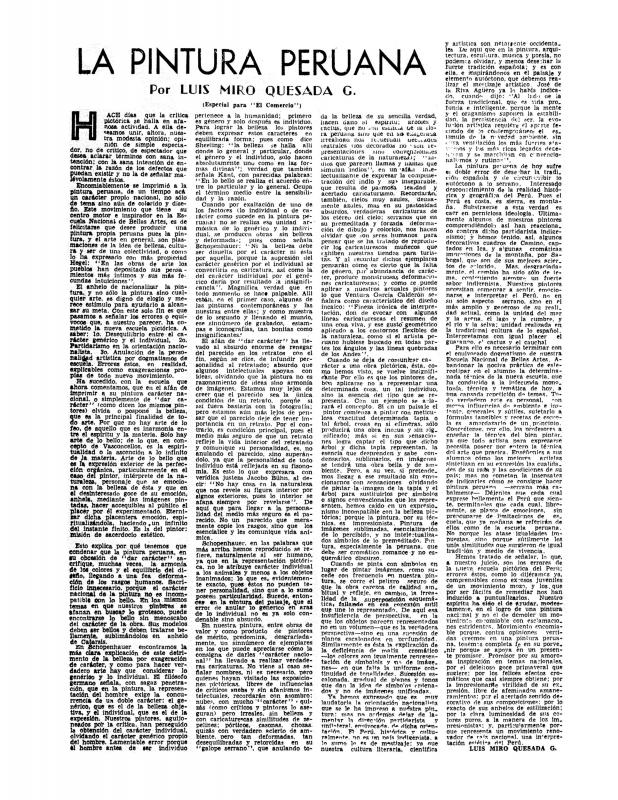This is an article by Ernesto More, under the pseudonym of “Jerome,” in which he criticized the academic orientation assumed by the ENBA (Escuela Nacional de Bellas Artes) in the Peruvian capital. In August of 1935, Lima’s weekly newspaper Cascabel published a devastating article on the ENBA questioning its teaching methods, as well as, the dogmatic indigenous orientation imposed by its director, José Sabogal (1888–1956). There were two additions made to the article with additional collected criticisms against ENBA. One of the formulated criticisms added were by artists with heterogeneous artistic tendencies and the other was from less distinguished academicians, such as Luis Ugarte (1877–1948) and Francisco González Gamarra, and even the insular figure of César Moro (1903–56), the most radical avant-gardist of the artistic milieu in Peru. Between the two positions were a series of personalities who were pursuing the thematic of the vernacular landscape but were independent to the aesthetics promoted by Sabogal (such as the artist Domingo Pantigoso and the sculptor Romano Espinoza Cáceda, among them). The journalist and writer Ernesto More was the person in charge of fusing all these opinions together and who took the initial steps to generate a block to counter attack the exclusionary presence of indigenism at the ENBA. A friend and mediator of César Vallejo, Ernest More became acquainted with the modern artistic trends during a stay in Europe between 1927–28 on a trip he made together with his brother Carlos, a self-taught artist. In fact, in 1930 this latter artist marked the first explicit differentiation regarding indigenism, presenting a proposal of reconciliation, with rather discrete results, and the representation of the country by means of a formalistic understanding in the Visual Arts. The attack on Sabogal was printed on the editorial line of the weekly newspaper and was directed by Federico More, the brother of Ernesto More and Carlos More, a controversial journalist who was in support of radical modernization that would leave behind the indigenous and Hispanic traditionalists, while promoting the idea an idea of searching a localized identity based on popular urban manifestations. [Please refer to the ICAA digital archive and the following texts: “Varios artistas opinan que es absolutamente necesario reformar los Institutos de arte en el Perú” (doc. no. 1143159) and “Se impone una reforme en nuestros Institutos de arte, en el Perú” (doc. no. 1143192) by Ernesto and Federico More Barrionuevo; “La pintura peruana” by Luis Miró Quesada G. (doc. no. 1143372); “Dieciséis años que la llamada Escuela de Bellas Artes, hace como que trabaja, y se consume estérilmente con el dinero del Fisco sin rendir ningún resultado: Como se asfixia el arte” by Ernesto More (doc. no. 1143210)].




